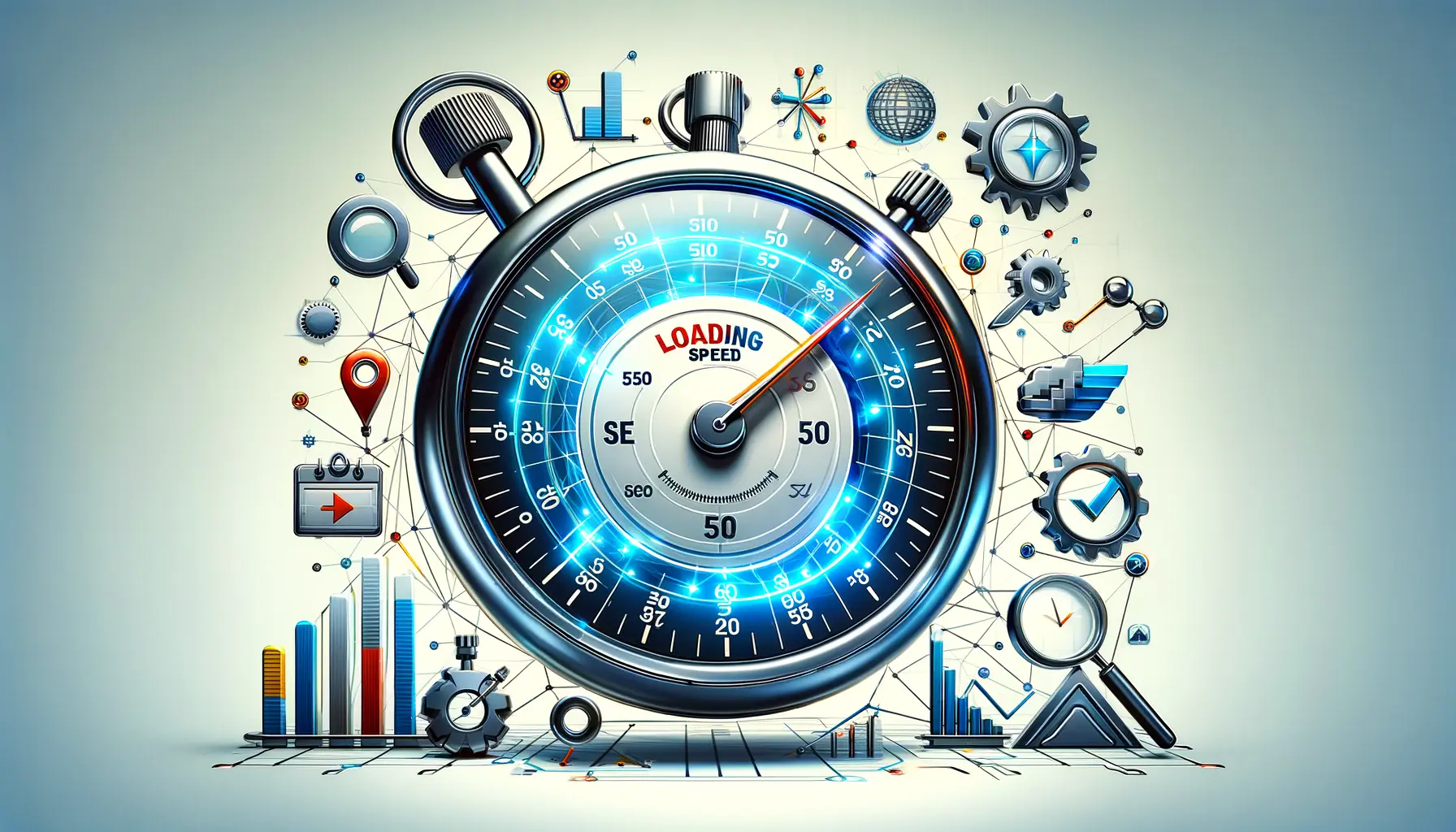In the ever-evolving world of digital marketing, the performance of a webpage is not just about its aesthetic appeal or content quality.
It’s increasingly about how quickly and efficiently it loads and interacts with the user.
This is where the concept of SEO Page Performance comes into play, intertwining the technical aspects of web development with the strategic elements of Search Engine Optimization (SEO).
The importance of page performance in SEO cannot be overstated.
In an age where user experience (UX) dictates the success of a website, the speed at which a page loads and responds to user interaction plays a pivotal role.
This article delves into the intricate relationship between page speed, user experience, and their collective impact on SEO.
- Understanding the Impact of Page Speed on SEO
- Strategies for Enhancing Page Speed
- Understanding the Role of UX in SEO
- Advanced Techniques in Page Speed Optimization
- SEO and User Experience: A Symbiotic Relationship
- Challenges and Solutions in Balancing Page Speed with UX
- Future Trends in Page Speed and UX Optimization
- Concluding Insights on SEO Page Performance
- SEO Page Performance: Essential FAQs
Understanding the Impact of Page Speed on SEO
Page speed refers to the time it takes for a webpage to load its content fully.
It’s a critical factor in SEO as it directly influences user experience.
Search engines like Google prioritize websites that load quickly, considering them more user-friendly and thus, more deserving of a higher ranking in search results.
The rationale behind this is straightforward: faster websites provide a better user experience.
Users are less likely to abandon a webpage that loads quickly, which in turn reduces bounce rates and increases the likelihood of engagement and conversion.
Core Web Vitals: The New SEO Benchmarks
Google’s recent emphasis on Core Web Vitals has further highlighted the importance of page speed in SEO.
These vitals are a set of specific factors that Google considers important in a webpage’s overall user experience.
They include metrics like Largest Contentful Paint (LCP), First Input Delay (FID), and Cumulative Layout Shift (CLS), each measuring different aspects of a website’s performance and user experience.
A website that scores well on these Core Web Vitals is more likely to rank higher in search engine results pages (SERPs), as it is deemed to offer a superior user experience.
This shift underscores the need for SEO strategies to focus not just on content and keywords but also on the technical performance of a webpage.
Key Point: Optimizing for Core Web Vitals is essential for improving SEO rankings and enhancing user experience.
Page Speed and User Behavior
The connection between page speed and user behavior is undeniable.
Statistics show that a delay of even a second in page load time can significantly impact customer satisfaction, lower page views, and hurt conversion rates.
In the mobile-first world, where the majority of searches are conducted on mobile devices, this becomes even more critical.
A fast-loading website is more likely to retain users, encouraging them to explore more pages and engage with the content.
This not only improves the chances of conversion but also sends positive signals to search engines, further boosting the website’s SEO performance.
Strategies for Enhancing Page Speed
Improving page speed is a multifaceted process that involves various technical strategies.
Implementing these can significantly boost a website’s performance, making it more appealing to both users and search engines.
Here are some key strategies to enhance page speed:
Optimizing Images and Media Files
Large images and media files can drastically slow down a website.
Optimizing these files is crucial for improving page load times.
This can be achieved through:
- Compressing images without losing quality.
- Using modern, efficient image formats like WebP.
- Implementing lazy loading to delay loading images until they are needed.
Minimizing HTTP Requests
Each element on a webpage, such as scripts, stylesheets, and images, requires an HTTP request to load.
Reducing these requests can significantly improve page speed.
Strategies include:
- Combining multiple CSS or JavaScript files into single files.
- Using CSS sprites to combine multiple images.
- Removing unnecessary widgets and plugins.
Utilizing Browser Caching
Browser caching stores webpage resource files on a local computer when a user visits a webpage.
This means that the browser doesn’t have to reload the entire page when a user returns to that page or visits another page on the site.
Techniques include:
- Setting appropriate expiry dates on caching.
- Configuring ETags to help browsers understand when to use cached resources.
Improving Server Response Time
The server response time is another critical factor in page speed.
Enhancing it involves:
- Optimizing the web server configuration.
- Upgrading to a faster hosting solution if necessary.
- Implementing a Content Delivery Network (CDN) to distribute the load.
Idea: Regularly monitoring and testing your website’s speed using tools like Google PageSpeed Insights can provide valuable insights into areas needing improvement.
Optimizing Code
Clean and efficient code can significantly boost a website’s loading speed.
This involves:
- Minifying CSS, JavaScript, and HTML.
- Removing render-blocking JavaScript and CSS in above-the-fold content.
- Using asynchronous loading for CSS and JavaScript files.
By implementing these strategies, websites can significantly improve their page load times, enhancing user experience and SEO performance.
It’s important to remember that page speed optimization is an ongoing process, requiring regular monitoring and updates to maintain optimal performance.
Understanding the Role of UX in SEO
User Experience (UX) plays a pivotal role in SEO, influencing how visitors interact with a website and ultimately, how search engines rank it.
A well-designed UX can lead to better engagement, lower bounce rates, and higher conversion rates.
Here’s how UX intertwines with SEO:
Mobile Responsiveness and UX
With the increasing use of mobile devices for web browsing, mobile responsiveness has become a key aspect of UX and SEO.
A mobile-responsive website adjusts seamlessly to different screen sizes, providing an optimal experience for all users.
This includes:
- Flexible images and fluid grids that adapt to the screen size.
- Touch-friendly navigation and buttons.
- Fast loading times on mobile devices.
Intuitive Navigation and Site Structure
An intuitive site structure and easy navigation enhance the user experience, making it easier for visitors to find what they are looking for.
This includes:
- Clear and logical navigation menus.
- Well-organized content with proper headings and subheadings.
- A search function for easy access to specific content.
Content Readability and Layout
The readability of content and its layout on a webpage are crucial for keeping users engaged.
This involves:
- Using legible fonts and appropriate font sizes.
- Ensuring sufficient contrast between text and background.
- Using bullet points and lists to break down content.
Interactive Elements and Visual Design
Interactive elements and an appealing visual design can significantly enhance user engagement.
This includes:
- Incorporating multimedia elements like images and videos.
- Using call-to-action buttons effectively.
- Maintaining a consistent and visually appealing color scheme.
Note: While enhancing UX, it’s essential to ensure that these improvements do not negatively impact page speed.
Ultimately, the goal of UX in SEO is to create a seamless and enjoyable experience for users, which in turn signals to search engines that the website is valuable and deserves a higher ranking.
Balancing UX with technical SEO elements is key to achieving a well-optimized website.
Advanced Techniques in Page Speed Optimization
While basic optimization strategies are essential, diving into more advanced techniques can further enhance page performance and SEO.
These sophisticated methods require a deeper understanding of web technologies but can yield significant improvements in page speed.
Implementing Advanced Caching Mechanisms
Advanced caching techniques go beyond browser caching, involving server-side and network-level optimizations.
These include:
- Using server-side caching to store fully rendered pages.
- Implementing application caching with service workers for offline usage.
- Utilizing edge caching on CDNs for faster content delivery.
Optimizing Critical Rendering Path
The Critical Rendering Path refers to the sequence of steps the browser goes through to convert HTML, CSS, and JavaScript into a rendered webpage.
Optimizing this path can significantly reduce load times:
- Minimizing the amount of critical resources.
- Deferring non-critical resources until after the page has loaded.
- Optimizing the order in which critical resources are loaded.
Utilizing HTTP/2 for Improved Performance
HTTP/2 introduces several enhancements over HTTP/1.1, including multiplexing and server push, which can improve page load times:
- Enabling multiplexing to send multiple requests for data in parallel over a single TCP connection.
- Using server push to send critical resources to the browser before they are requested.
Adopting Progressive Web App (PWA) Technologies
PWAs use modern web capabilities to deliver app-like experiences.
They can significantly improve page speed and user engagement:
- Implementing service workers for background data loading and caching.
- Using app shells for instant loading of app interfaces.
- Enabling offline functionality for better user experience in low connectivity.
Truth: Advanced page speed optimization techniques can be complex but are essential for websites with high traffic and large-scale operations.
These advanced techniques require a certain level of expertise in web development but can dramatically improve the performance of a website.
They are particularly beneficial for websites with high traffic volumes or those offering complex functionalities.
SEO and User Experience: A Symbiotic Relationship
The relationship between SEO and user experience (UX) is symbiotic and integral to the success of any website.
While SEO focuses on making the website more visible and accessible to search engines, UX aims to provide a positive and seamless experience for the user.
The two, when combined effectively, can lead to a significant boost in website performance and user satisfaction.
SEO-Driven Design for Enhanced UX
Designing a website with SEO in mind doesn’t mean sacrificing UX.
In fact, SEO-driven design can enhance the user experience:
- Creating content that is not only keyword-rich but also valuable and engaging for the user.
- Designing a site layout that is easy to navigate, helping users find the information they need quickly.
- Ensuring that the website is accessible to all users, including those with disabilities, enhancing overall UX.
UX Elements That Boost SEO
Certain UX elements can directly contribute to improving a website’s SEO:
- Clear and concise headings and subheadings that aid in content organization and keyword optimization.
- Engaging and interactive elements like videos and infographics that can increase user dwell time.
- Responsive design that ensures the website performs well across all devices, a factor that search engines consider.
Feedback Loop Between User Behavior and SEO
User behavior metrics like click-through rate (CTR), time on site, and bounce rate provide valuable feedback for SEO:
- Improving these metrics through better UX can signal to search engines that the website is of high quality and relevance.
- Search engines use these metrics to refine their algorithms, further emphasizing the importance of a good UX in SEO strategies.
Featured Info: A website that excels in both SEO and UX is more likely to achieve higher rankings, attract more traffic, and have better conversion rates.
Ultimately, the goal is to create a website that not only ranks well in search engines but also provides an exceptional experience for the user.
This dual focus on SEO and UX can lead to a virtuous cycle of increased visibility, higher traffic, and improved user engagement.
Challenges and Solutions in Balancing Page Speed with UX
Balancing page speed with a rich user experience (UX) can be challenging.
High-quality content and interactive features that enhance UX might slow down a page, while efforts to boost speed might strip away these valuable elements.
Understanding these challenges and implementing effective solutions is key to maintaining this balance.
Challenge: High-Quality Images and Media Impacting Load Time
High-resolution images and videos greatly enhance UX but can significantly slow down page load times.
Solutions include:
- Compressing and optimizing images to reduce file size without compromising quality.
- Using responsive images that adjust in size based on the user’s device.
- Implementing lazy loading so that images load only when they come into the viewport.
Challenge: Interactive Features Slowing Down the Page
Interactive elements like animations and hover effects improve engagement but can add to the page load time.
Solutions involve:
- Using CSS3 animations instead of JavaScript for lighter, more efficient animations.
- Ensuring scripts are optimized and non-blocking.
- Asynchronously loading heavier interactive features.
Challenge: Maintaining a Mobile-Friendly Site Without Sacrificing Speed
Creating a mobile-friendly site is essential for UX but can introduce speed issues, especially on slower mobile networks.
Solutions include:
- Adopting a mobile-first design approach to ensure efficiency and speed.
- Minimizing the use of heavy scripts and large images on mobile versions.
- Utilizing AMP (Accelerated Mobile Pages) for faster loading on mobile devices.
Challenge: Rich Content Increasing Page Load Time
Rich content like high-quality videos and interactive infographics enhances UX but can slow down the page.
Solutions include:
- Hosting videos on external platforms like YouTube and embedding them on the site.
- Optimizing infographics and other rich content for quick loading.
- Providing alternative content for users with slower connections.
False Information: It’s a common misconception that improving page speed always requires sacrificing UX elements. With the right strategies, it’s possible to maintain both.
By addressing these challenges with effective solutions, websites can achieve a harmonious balance between fast load times and a rich, engaging user experience.
This balance is crucial for retaining users, improving SEO rankings, and ultimately achieving online success.
Future Trends in Page Speed and UX Optimization
The landscape of web development is constantly evolving, with new trends emerging in page speed and UX optimization.
Staying ahead of these trends is crucial for SEO success and providing an exceptional user experience.
Here are some future trends that are shaping the way websites are developed and optimized:
Artificial Intelligence and Machine Learning in Optimization
AI and machine learning are becoming increasingly influential in web optimization.
Future trends include:
- Automated image and content optimization based on user behavior and preferences.
- Machine learning algorithms to predict and preload user-requested content.
- AI-driven tools for real-time website performance monitoring and optimization.
Increased Focus on Mobile-First Design
As mobile usage continues to rise, mobile-first design will become even more prevalent.
This includes:
- Designing websites primarily for mobile devices, ensuring speed and usability.
- Developing features and content that cater specifically to mobile users.
- Optimizing for mobile-specific SEO factors.
Adoption of Progressive Web Apps (PWAs)
PWAs are set to become more mainstream, offering app-like experiences on the web.
This trend involves:
- Creating web applications that load quickly and work offline.
- Utilizing service workers for background data fetching and caching.
- Enhancing user engagement with push notifications and seamless updates.
Greater Emphasis on User-Centric Performance Metrics
User-centric metrics, such as those in Google’s Core Web Vitals, will gain more importance.
This includes:
- Focusing on metrics that directly impact user experience, like loading time, interactivity, and visual stability.
- Customizing content and features based on user-centric data and feedback.
- Continuously adapting SEO strategies to align with evolving user behavior patterns.
Idea: Embracing these future trends in page speed and UX optimization can position a website at the forefront of digital innovation, enhancing both its SEO performance and user satisfaction.
As technology advances, the integration of these trends will become crucial for websites looking to stay competitive and relevant.
Keeping abreast of these developments and incorporating them into web design and optimization strategies will be key to achieving long-term success in the digital space.
Concluding Insights on SEO Page Performance
In the dynamic world of digital marketing, the significance of SEO Page Performance is paramount.
This article has traversed the intricate relationship between page speed, user experience (UX), and their collective impact on SEO.
The journey from understanding the basics to exploring advanced optimization techniques reveals a clear message: a harmonious balance between speed and UX is not just desirable but essential for SEO success.
Key Takeaways
Reflecting on the insights presented, several key takeaways emerge:
- Page speed is a critical factor in SEO, influencing user engagement, satisfaction, and search engine rankings.
- Optimizing images, minimizing HTTP requests, and implementing advanced caching are pivotal for enhancing page speed.
- UX elements like mobile responsiveness, intuitive navigation, and interactive features play a significant role in SEO.
- Emerging trends like AI in optimization and the rise of PWAs are shaping the future of web development.
Final Thoughts
The journey towards optimizing SEO Page Performance is ongoing and dynamic.
As technology evolves, so do the strategies for balancing page speed with a rich UX.
Staying informed and adaptable to these changes is crucial for any website aiming to rank high in search engine results.
Ultimately, the goal is to create a seamless, engaging, and fast-loading website that not only appeals to users but also meets the rigorous standards of search engines.
In conclusion, the pursuit of optimal SEO Page Performance is a journey worth embarking on.
It requires a blend of technical know-how, creative design, and a keen understanding of user behavior.
By prioritizing both page speed and UX, websites can achieve greater visibility, higher traffic, and improved user engagement, leading to a successful online presence in the competitive digital landscape.
Want your website to top Google search rankings? Leave the SEO to our professional agency!
SEO Page Performance: Essential FAQs
Understanding SEO Page Performance is crucial for optimizing your website’s visibility and user experience. Here are some frequently asked questions to deepen your knowledge in this area.
SEO Page Performance refers to how well a webpage loads and functions, impacting its ranking in search engine results and overall user experience.
Page speed is a key SEO factor as it influences user experience, bounce rates, and engagement, directly affecting a website’s search engine ranking.
Core Web Vitals are a set of specific metrics by Google that measure a webpage’s loading performance, interactivity, and visual stability for SEO.
Yes, optimizing images by compressing and resizing them can significantly improve page speed without compromising on quality.
UX plays a crucial role in SEO as it affects user engagement and satisfaction, which are key factors in how search engines rank websites.
Mobile responsiveness is vital for SEO as it ensures a good user experience across all devices, a factor highly valued by search engines.
Advanced caching mechanisms improve page load times and user experience, contributing positively to a website’s SEO performance.
Future trends in SEO and UX include AI-driven optimization, increased focus on mobile-first design, and adoption of Progressive Web Apps (PWAs).










